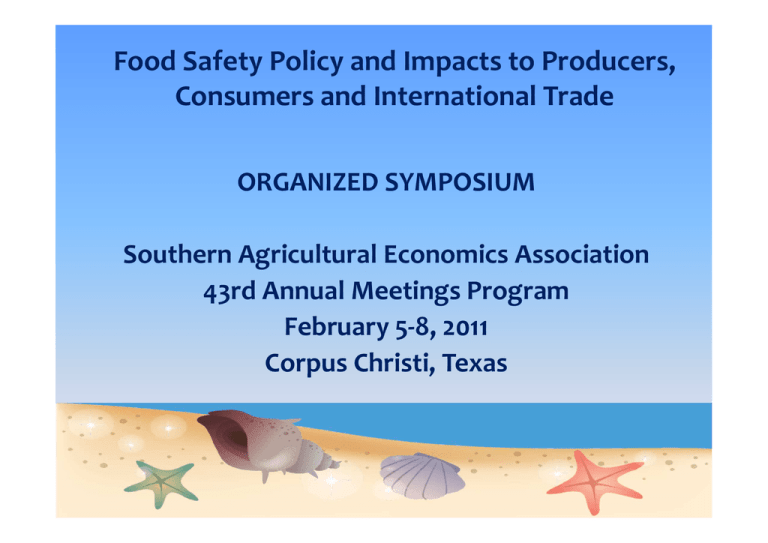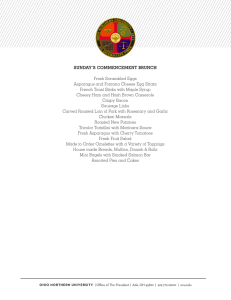Food Safety Policy and Impacts to Producers, Consumers and International Trade
advertisement

Food Safety Policy and Impacts to Producers, Consumers and International Trade ORGANIZED SYMPOSIUM Southern Agricultural Economics Association 43rd Annual Meetings Program February 5-8, 2011 Corpus Christi, Texas Presented by Mechel Paggi Director, Center for Agricultural Business www.csufcab.com Authors: Mechel Paggi & Fumiko Yamazaki, CSUF Luis Ribera, Ronald D. Kuntson, Juan Anciso, & Marco Palma, TAMU Jay Noel, California Polytechnic State University, San Luis Obispo •Food Safety is an Important Goal •Food Safety is a problem that can occur at any point in the supply chain •International efforts are necessary to insure food safety in an increasingly global food supply Chain Detection and control of foodborne illness Is difficult, timely and damage has usually Already been done, or at least some damage By the time the source is identified correctly The time from the beginning of the patient’s illness to the confirmation that he or she was part of an outbreak is typically about 2-3 weeks. Case counts in the midst of an outbreak investigation must be interpreted within this context. The Centers for Disease Control Has Finally Updated the Estimate Of People Suffering from Foodborne Illness In the US Illnesses Hospitalizations Deaths 1999 76 million 325,000 5,000 2010 47.8 million 127,839 3,037 Major Pathogens 9.4 million 55,961 1,351 Unspecified Agents 38.4 million 71,878 1,686 Major Pathogens 1. norovirus (formally Norwalk agent) likely responsible For 90% of the outbreaks of gastroenteritis around the world. Fecally contaminated Food or water. 2. salmonella 3. T. gondii (the cat bug) Note to self: In a linear sense by 2030 the problem will be solved Food Safety is A Complicated Goal Food Safety Issues Salmonella Saint Paul In Fresh Tomatoes June 3, 2008 Ultimately Actual Cause Linked to: From Mexico Estimated Cost to U.S. Tomato Industry: $100 million The Economic Health of the Industry Roberta Cook, November 2007 New Ex-Post Assessments May Add Knowledge To Aid in Prevention in the Future • So Taking Measures to Minimize contamination is a sensible approach • Standards that are acceptable across governmental boundaries is a good idea in a global environment • But who sets those standards? • Can one size fit all? • Where are we? • Where might we be going? Who sets the standards • International organizations (CODEX, OIE, IPPC, WTO, ISO) • National government organizations (Mexico, US, EU) • Private international organizations (GLOBALGAP) • Private national organizations (FLSC) • Private firms (WalMart, COSTCO) • Producer organizations (LGMA) • All influenced to some degree by advocacy groups (PETA etc) Standards Have Proliferated and Compete So A Move Toward Harmonization has Emerged In the Private Sector Industry seeks accord on single GAP audit standard by Joan Murphy 10/15/2009 The produce industry has long complained about competing Good Agricultural Practice audits, and now a new working group will meet next month to start hammering out a single standard for all third-party GAP audits by October 2010. "We've created a monster allowing different standards to propagate," said David Gombas, project coordinator for the GAP harmonization effort and senior vice president for food safety and technology at the United Fresh Produce Association. As We Can See, this is a very complex issue Many different areas to examine Our study takes a look at one small, but we think Important, piece of the puzzle. What is the impact of this quest for improved food safety On producers. To Make it even more manageable we look at fresh produce, and do not try to take on milk, meat, eggs and more processed product categories. The Multiple Standards Issue is not Unique to the US Producer Information Suggest There are Economies of Scale and that Small Holders Face Disadvantages IFPRI Discussion Paper 00737 December 2007 Small holder up to 2 acres; small holder groups 15 members; The exact number of smallholders that have been marginalized by the IFSS is unknown, but in Kenya, evidence from a few leading exporters suggests that more than half of the small growers were dropped immediately following imposition of IFSS. Consequently, while over 60% of green beans were produced by smallholders in Kenya in 1980s, this share had dropped to about 30% by 2003 (Jaffee, 2004, Kimenye, 1993). Information Suggest There are Economies of Scale and that Small Holders Face Disadvantages IFPRI Discussion Paper 00737 December 2007 Small holder up to 2 acres; small holder groups 15 members; The exact number of smallholders that have been marginalized by the IFSS is unknown, but in Kenya, evidence from a few leading exporters suggests that more than half of the small growers were dropped immediately following imposition of IFSS. Consequently, while over 60% of green beans were produced by smallholders in Kenya in 1980s, this share had dropped to about 30% by 2003 (Jaffee, 2004, Kimenye, 1993). Various Standards Facing US Fresh Produce Producers Cost of Standards Compliance, Fresh Strawberry Production Average Food Safety Related Costs Increases From LGMA Compliance Regulatory Cost Compliance Across Interstate Boundaries Food Safety & Others Influence of Increased Costs on Profitability Influence of Increased Costs on Profitability Proposed Food Safety Administration : “One Program/One Strategy Proliferation of Influences Particularly Evident in the West A Formidable Task to Address the All Major Challenge Need for Convergence of Multiple Process Standards * National International United States Food and Drug Administration GlobalGAP X Producer Industry/Retail California Leafy Green Marketing Association Safety Leadership Council Wal-Mart Producer Dilemma * The International Federation for Produce Standards (IFPS) Work is Continuing • Lettuce: CA / ARZ • Strawberry: CA /FLA/Mexico • Fresh Tomatoes: CA/FLA/Mexico • Additional Monitoring of the







